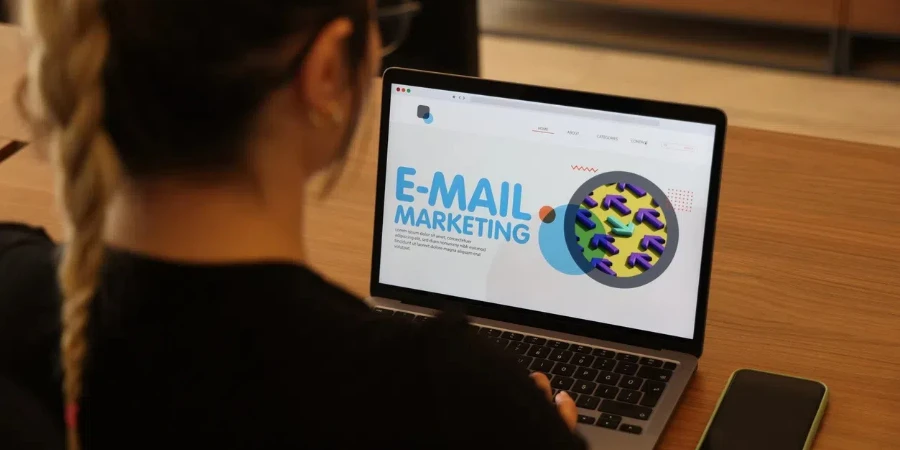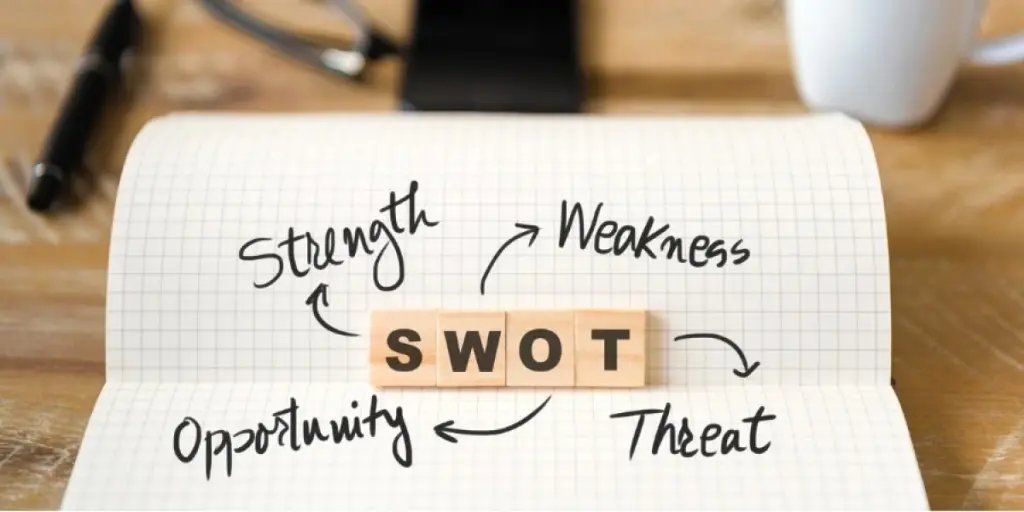Table of Contents
1. What is email marketing?
2. Why email marketing is important
3. How effective is email marketing?
4. Email marketing best practices for 2024
5. How does email marketing work?
6. Best email marketing campaign examples
7. Types of email marketing campaigns
8. How do you write compelling email content?
9. Email marketing metrics and analytics
10. Common email marketing mistakes to avoid
11. Conclusion
Undoubtedly, flashy social media ads and video marketing campaigns have the potential to offer immediate customer engagement. But, email marketing remains one of the most potent ways to build a loyal base over time.
It is a powerful tool with long-term ROI for any business and offers a direct line of communication with your audience, fostering stronger relationships. By sending relevant and compelling emails, you can harness the power of this strategy to grow your business and gain consistent profits.
In this article, we discuss email marketing and its continued importance. We also share some best practices tailored to the current marketing scenario to ensure your email marketing efforts yield the desired results.
What is email marketing?
Email marketing is the practice of reaching out to potential and existing customers via email. Businesses use this strategy to promote products and share relevant information because it is cost-effective and enables direct communication with their audiences.
The critical components of email marketing include newsletters, promotional emails, transactional emails, and re-engagement emails. Each type serves a specific purpose, helping businesses stay connected with their audience.
Email marketing dates back to the 1970s, with Gary Thuerk sending the first commercial email. Since then, it has evolved from basic promotional messages into sophisticated, targeted campaigns.
Businesses are harnessing the power of data to create more targeted and personalized email marketing campaigns. Advances in technology have further revolutionized this field, making it possible to seamlessly integrate email marketing with other strategies, such as social media campaigns, SMS marketing, and personalized landing pages.
Email marketing offers many benefits. For one, it provides a better return on investment than other strategies. Its cost-effectiveness and the ability to reach a vast audience make it a valuable strategy for maximizing marketing efforts.
Why email marketing is important
As digital marketing strategies have evolved, one question keeps popping up: “Is email marketing effective to this day?” The answer is a resounding yes.
Despite the rise of several digital channels, marketing emailing still holds significant importance. Let’s break down why:
- Direct and personalized communication: With email marketing, you’ll get a direct line of communication with your customers. You can tailor your messages to suit specific customer demographics and preferences.
- Cost-effectiveness: Email marketing is a budget-friendly strategy that delivers a high ROI. According to our survey data, for every $1 spent on email marketing by US businesses, the average ROI is $73.20. This is quite high compared to an ROI of $22 for SEO marketing and $2 for paid advertising for every dollar spent.
- Performance monitoring: Email marketing platforms allow you to track the performance of your campaigns. This data is gold for understanding your audience and fine-tuning even your best email marketing campaigns.
- Customer loyalty and retention: Marketing by email is a great way to nurture customer relationships. Especially when you maintain a consistent emailing schedule, your brand stays at the forefront of customers’ minds, helping to build trust and strengthen relationships.
How effective is email marketing?
The effectiveness of email marketing can be gauged through various performance metrics and industry benchmarks. Here’s a detailed look at these aspects:
Key performance metrics (KPIs)
Marketers rely on several metrics and statistics to measure how successful their email marketing campaigns are. Such KPIs include:
- Open rates: The percentage of recipients who open your email. A high open rate suggests compelling subject lines and relevant content.
- Click-through rates (CTR): The percentage of recipients who click on the links contained in your email. A strong CTR indicates that the content is engaging and relevant.
- Click-to-conversion: This involves those who followed a link in your email and completed a target action. Tracking this metric can provide insight into which links are most compelling.
- Conversion rates: This metric tracks the percentage of recipients who complete a desired action, such as making a purchase, filling out a survey, or claiming a free trial.
- Unsubscribe rates: Recipients may opt out of receiving future emails. Monitoring this metric helps identify potential issues with email content relevance or frequency.
Industry benchmarks and statistics
Let’s face it — numbers don’t lie. Industry benchmarks can help you gauge your email campaign performance. According to our recent email marketing statistics, here are some benchmarks to measure against:
- Open rate: Average of 25.2% across all industries
- Average click rate: 1.5%
- Average click-to-conversion rate: 4.61%
- Average conversion rate: 0.07% across all industries
Here are the five top and lowest-performing industries in terms of email marketing conversion rate:
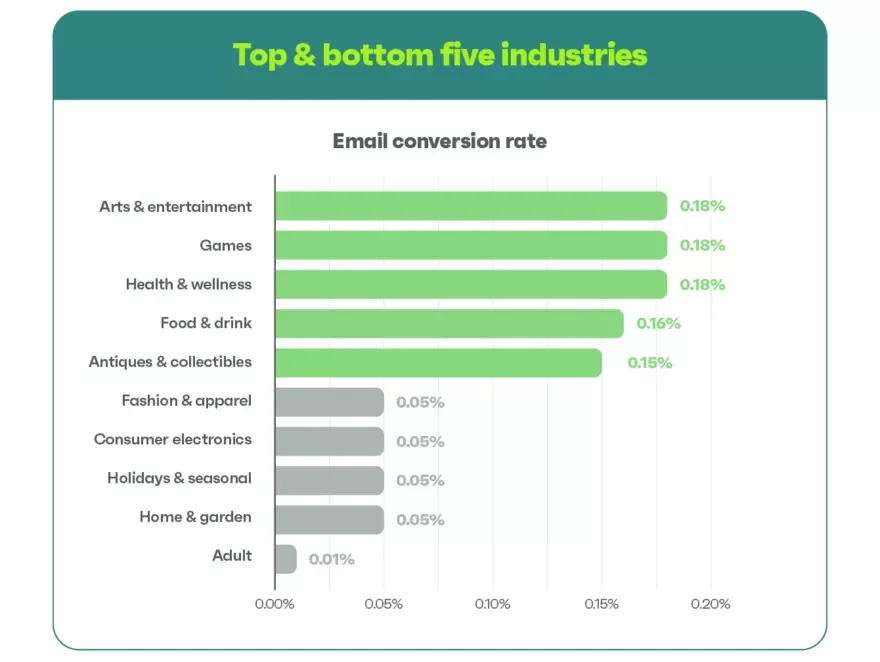
These benchmarks provide a baseline to measure your campaigns. However, these are just averages. Top performers can achieve higher numbers. Factors like email list quality, content relevance, and subject line effectiveness can impact results.
Case studies of successful email marketing
Numerous businesses have harnessed the power of email marketing to achieve remarkable results. Here are some case studies to paint a picture of how effective email marketing is:
Creality
Despite being a leading player in the 3D printing industry, Creality faced a common ecommerce hurdle: abandoned carts. To address this issue, the brand partnered with Omnisend to create targeted abandoned cart email campaigns.
The impact of these campaigns was remarkable. Within less than a year of implementation, the company achieved over €560,000 in generated sales. It also achieved open rates of 54% and click rates of 8.25%, demonstrating the effectiveness of the email campaigns.
To’ak Chocolate
Another case study is To’ak Chocolate, a brand known for its luxury single-origin chocolate. Despite its respectable marketing results, it wanted to improve its ROI and decided to focus more on email marketing.
To’ak Chocolate partnered with Omnisend to enhance the results of its email marketing strategy. Key elements of the approach included crafting a compelling welcome email series for To’ak Chocolate’s story and products.
Other implemented strategies include automated email sequences for abandoned carts, order confirmations, and post-purchase engagement. The brand achieved a 460% increase in sales in six months.
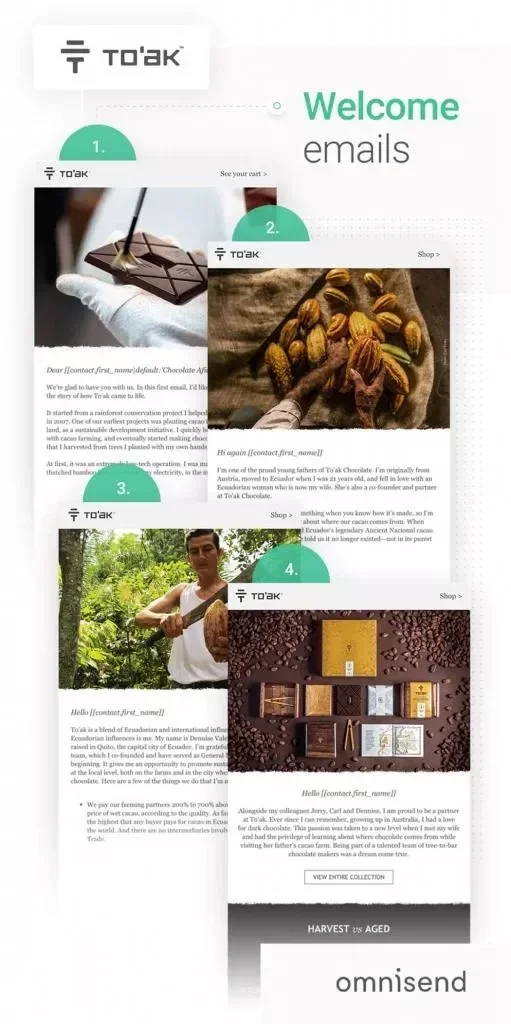
Comparison with other marketing channels
Here’s how email marketing stacks up against other marketing approaches:
- Email vs. social media: Social media can offer real-time engagement. However, organic reach is declining. With email marketing, you can have more personalized interactions with your audience.
- Email vs. paid advertising: Paid advertising can generate quick results, but costs can add up. Email marketing can offer better long-term ROI at lower costs.
- Email vs. content marketing: Content marketing can build brand authority, but it may take time to see results. Email marketing can deliver immediate engagement due to its direct reach.
Future trends in email marketing for 2024
As we look ahead, several email marketing trends are expected to contribute to the effectiveness of email campaigns. Here are some future trends to watch out for in 2024:
- AI and automation: AI will enable more personalized and timely emails. Then, automation will continue to streamline campaign management, making it easier to send targeted and timely messages.
- Interactive emails: Incorporating interactive elements like polls or quizzes will become more common, making emails more engaging and enjoyable for recipients.
- User-generated content: User-generated content in emails will become more prevalent. This will help build trust and increase engagement.
- Focus on mobile optimization: The number of users accessing emails on mobile devices is increasing, so optimizing email designs for mobile viewing will become more critical.
Email marketing best practices for 2024
Executing email marketing campaigns requires a strategic approach to drive good results. Here are some email marketing best practices you can follow to maximize your efforts this year:
Personalization and segmentation
Receiving a constant stream of irrelevant emails can be annoying. But by using email segmentation and personalization, you can avoid overwhelming your subscribers, ensuring they receive only the content that interests them.
Create distinct audience segments using categories like demographics and purchase history. Then, tailor email sequences to their interests and needs.
The more granular your contact data, the better equipped you’ll be to deliver personalized email campaigns.
For personalization, the standard is to send content that aligns with where they are in the sales funnel.
Mobile optimization
According to the Forbes 2024 report, mobile devices account for 41% of email opens, so optimizing emails for mobile viewing is important.
Here are some elements you can prioritize to ensure your emails are optimized for mobile:
- Responsive design: Your email’s layout should adapt to different screen sizes. This means images resize proportionally, and texts are readable without zooming.
- Image optimization: Large image files can slow loading times, especially on mobile networks. Compress images without compromising quality to accelerate rendering. Also, alt text for images should be used for better accessibility and improved search engine visibility.
- Single-column layout: Multi-column layouts can be appealing on desktops. However, they often become cluttered on smaller screens. Opt for a single-column layout to maintain clarity and avoid horizontal scrolling.
A/B testing
You can compare different email versions to identify which variation ensures optimal performance. The key email elements you can A/B test include:
- Subject lines with different texts and lengths to determine their performance

- Preheader text wording and placement
- Email copy
- Design and layout
- CTA design and placement
- Visuals
Timing and frequency
These two factors can impact your campaign’s effectiveness. Sending emails when your audience is most likely to engage can boost open rates and overall performance.
The optimal timing and frequency can vary depending on your industry, audience, and campaign goals. Consider the following factors:
- Time zones and locations of your subscribers
- Day of the week and time of day
- Frequency of other marketing communications
- Subscriber engagement levels
Our research on the best time to send emails indicates that emails delivered on Tuesdays and Fridays at 2 PM, 5 PM, and 8 PM generally have higher open rates. This time frame corresponds to periods when recipients are more likely to check their email.
Creating compelling subject lines
A compelling subject line can make the difference between an opened email and one that’s ignored. Since it’s often the first thing your subscribers see, it should be clear and attention-grabbing.
Some best practices for creating effective subject lines include:
- Keeping it short and concise (ideally under 50 characters)
- Using personalization, such as the recipient’s name or location
- Incorporating emojis or special characters to stand out
- Teasing the content of the email without giving everything away
- Creating a sense of urgency or scarcity, if appropriate
Ensuring deliverability
Even the best-written email won’t achieve its intended purpose if it doesn’t reach the recipient. That’s why deliverability is essential.
Here are some actionable tips for achieving strong deliverability rates:
- Use a recognizable sender name and email address
- Ensure your email list is clean and up-to-date by removing inactive subscribers regularly
- Avoid spam trigger words and excessive use of images
- Authenticate your emails using SPF, DKIM, and DMARC protocols
How does email marketing work?
Understanding the mechanics of email marketing, from planning to execution, can help you reach your goals. Below, we break down the essential components of a successful email marketing strategy.
Building an email list
The first step in setting up an email marketing campaign is building an email list. This list is a collection of email addresses from people interested in your business.
Here are some methods to grow your list:
- Opt-in forms: Place simple opt-in forms on your website or blog, requesting only essential information like name and email address to encourage customer signups
- Lead magnets: Offer something valuable, such as an ebook, discount code, or free trial, in exchange for an email address
- Social media: Use your social media platforms to encourage followers to subscribe to your email list
- Landing pages: Create dedicated landing pages that capture email addresses by highlighting the benefits of subscribing
- Contests and giveaways: Run contests or giveaways that require participants to provide their email addresses to enter
Segmenting your audience
Once you have a list, the next step is segmentation. You can categorize your list into smaller groups based on certain criteria for targeted messaging.
Here are some criteria for segmenting your list:
- Demographics: Segment by age, gender, location, or occupation
- Behavior: Group subscribers based on their behavior, such as past purchases, website activity, or email engagement
- Interests: Segment by engagement levels, such as active subscribers, occasional readers, and inactive subscribers
- Engagement levels: Identify active and inactive subscribers based on different engagement filters
- Signup source: Know where they signed up, whether from a webinar, a landing page, or a specific campaign

Crafting effective email content
To create an email campaign, you need compelling content to capture your audience’s attention and get them to act.
Let’s explore some elements that make up your email content.
- Subject lines: Write catchy and concise subject lines that spark curiosity or convey urgency. A/B testing different subject lines can help determine which ones can generate the best results.
- Email copy: Keep your messaging clear and concise, using short paragraphs, bullet points, and subheadings to enhance readability. Be sure to focus on the value you provide to the reader.
- Visuals: Incorporate images, infographics, or videos to make your emails visually appealing. Ensure that visuals are optimized for mobile devices.
- CTA: Include clear and compelling CTAs that guide subscribers on what to do next.
In addition to crafting email content, scheduling your emails at the right frequency is also important.
Here are some things to consider to maintain an optimal sending frequency:
- Create a sending schedule: Establish a regular sending schedule, whether it’s weekly, bi-weekly, or monthly. You can A/B test different days and times to determine when your audience is most responsive.
- Automate email sequences: Consider sending emails based on specific actions or events. You can set up automated emails triggered by actions taken by your subscribers.
Tools and platforms
You don’t need to be a tech expert to launch successful email marketing campaigns. Several user-friendly tools can help you manage your list, create emails, and track performance. Popular options include:
- Omnisend (with a focus on omnichannel marketing)
- Mailchimp
- Constant Contact
- Campaign Monitor
- AWeber
Compliance with regulations
Even with email marketing tools, you must adhere to certain data regulations to protect your customer data. Familiarize yourself with laws like the General Data Protection Regulation (GDPR) in the European Union and the CAN-SPAM Act in the United States.
These regulations cover data privacy, consent, unsubscribe options, and commercial email messages. By following these guidelines, you can create effective email marketing campaigns.
Best email marketing campaign examples
To inspire your campaign, we’ve curated a collection of successful email marketing campaign examples. Such campaigns are typically measured by key metrics like engagement rates, conversion rates, and ROI.
Campaign 1: Pinterest welcome email
Subject line: Happy first day of Pinterest!
Strategies used:
- Clear branding: Pinterest’s branding is evident through its logo, color scheme, and overall design aesthetic. This ensures that recipients recognize the email is coming from Pinterest.
- Highlighting features: The email outlines key features of Pinterest, such as creating boards and saving ideas. By highlighting these functionalities, the email informs subscribers about how they can utilize the platform to their advantage.
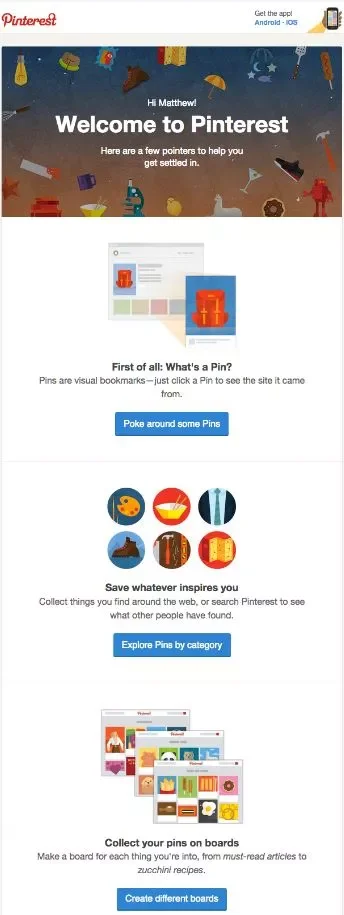
Campaign 2: Treehouse referral email
Subject line: Sharing Email from Treehouse
Strategies used:
- Personalization: The email addresses the recipient by name, creating a sense of personal connection. This is one of the best practices for enhancing engagement, as recipients will feel that the message is tailored for them.
- Simple and direct messaging: The email’s content is concise. It clearly outlines the benefits of referring a friend, such as rewards for both the referrer and the referred friend.
- Visual Appeal: The email has a clean layout and colors that align with Treehouse’s branding. This makes it not only attractive but also recognizable.

Campaign 3: Rael abandoned cart email
Subject line: We noticed you, noticing us. 😉
Strategies used:
- Incentivization: The free shipping offer for orders $50 and above encourages recipients to fill their carts and make more orders. This strategy leverages the fear of missing out (FOMO) to increase the chances of customers taking action.
- Product recommendations: Apart from reminding the recipient of the abandoned cart item, Rael includes recommendations for other products that might interest them. Recommending additional products can encourage upsells and cross-sells.

Types of email marketing campaigns
Email communication has evolved from its traditionally formal style. Today, tone and style adapt to match the recipient’s preferences. This creates a more personal and engaging connection.
Despite this shift, email structures remain important. Let’s explore the most common types of email marketing campaigns.
Welcome emails
These are sent to new subscribers of your email advertising list. They’re a great way to introduce your business and build relationships with newcomers.
Welcome emails often include links to useful information about the brand and its products. They may also feature a variety of media, such as videos, infographics, and downloadable resources.
For example, MailerLite sends a warm and friendly welcome email that highlights the benefits and features that await subscribers. It also includes links to some of their expert guides and embedded social media buttons.
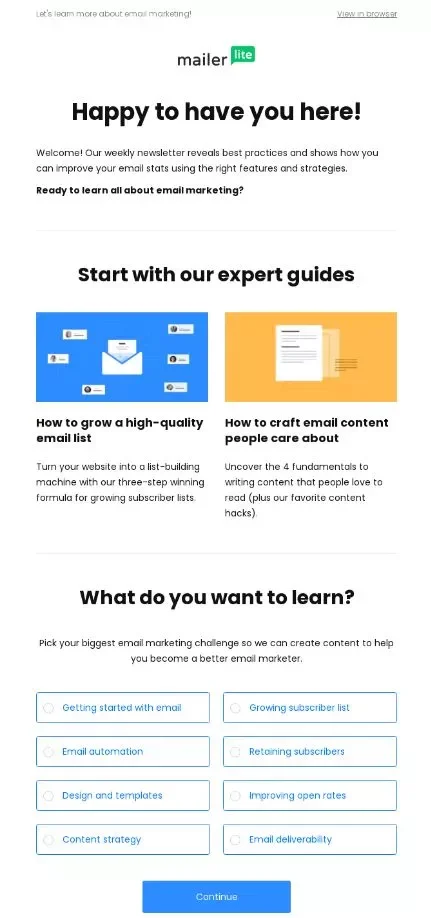
Newsletters
Newsletters are scheduled emails that deliver a curated selection of content to subscribers. Sent weekly, bi-weekly, or monthly, they are used to share company news, industry insights, and important updates.
Effective newsletters are both informative and engaging, making them essential for lead nurturing. Their versatility allows them to be customized for various audience segments.
Calm, a meditation brand, sends a weekly newsletter that provides mental health and wellness tips and resources.
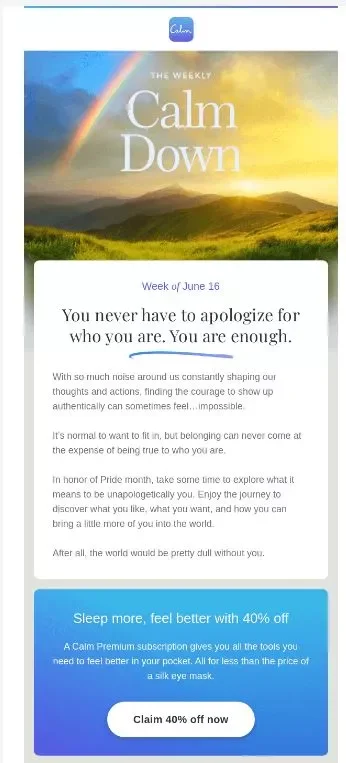
Promotional emails
Businesses send promotional emails to drive sales and conversions. These emails typically include special offers, discounts, or information about new products, creating a sense of excitement to encourage recipients to take action.
This Wix email is a good promotional email example. It highlights a limited-time sale with a percentage discount and features a bold and clear CTA button with a countdown timer to create urgency.
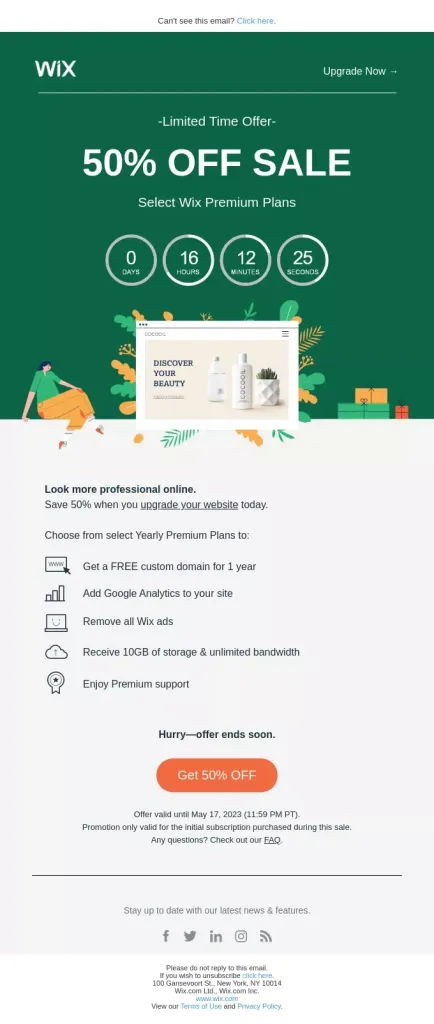
Transactional emails
You can send emails based on specific actions taken by the customer, such as making a purchase or resetting a password. These emails provide essential information related to the transaction and are typically automated.
Although their primary purpose is functional, transactional emails can also reinforce your brand and build customer loyalty.
For example, this email from Vevo is a confirmation message triggered to verify a user’s email address. It has a straightforward layout, guiding recipients to confirm their email by clicking on a prominent link.
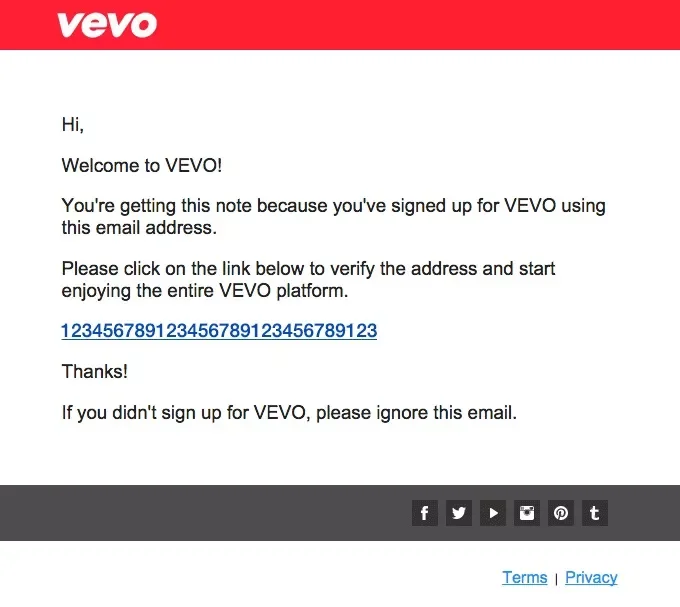
Re-engagement emails
These emails aim to rekindle interest in your brand by reaching out to subscribers who were once engaged but have since become inactive. The goal is to reignite their enthusiasm and reduce the risk of losing them.
Zoom, in this email, uses a light-hearted tone to highlight the lack of engagement from its subscribers. The email highlights the benefits and new features subscribers may be missing out on. This is done to encourage recipients to reactivate their accounts.
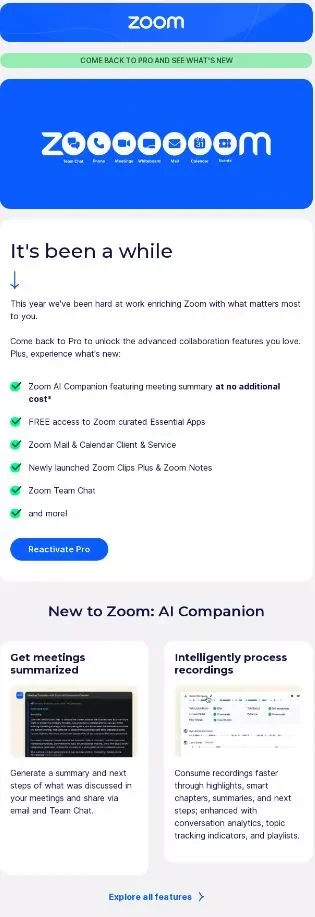
Abandoned cart emails
According to Statista, 70.19% of online shopping carts will be abandoned in 2024. This is where abandoned cart emails come in. These emails are follow-up messages sent to customers who leave a website without completing a purchase.
PlayStation uses a friendly and conversational tone to send a subtle reminder about their product. It includes a visual representation of the product along with a clear CTA to direct users back to their cart to finalize their order.
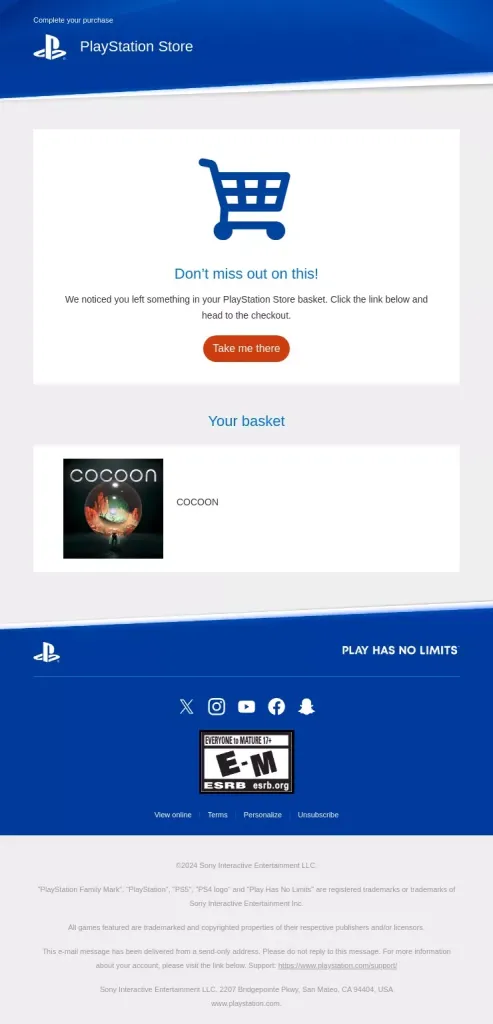
How do you write compelling email content?
Mastering persuasive copywriting is essential for creating the best email marketing campaigns. Whether you’re promoting a product or nurturing leads, your email content has a significant influence on your email campaign effectiveness.
Let’s discuss some email content tips to focus on while writing engaging and effective email advertising content:
Attention-grabbing subject lines
This is an important aspect of email marketing campaigns. In fact, optimizing your subject lines is the most effective strategy for boosting email open rates.
Here are some tips for crafting subject lines that grab attention and encourage opens:
- Be clear and concise: Aim for 6-10 words. This ensures your subject line is easy to read and understand at a glance and displays fully on any device.
- Use personalization: Include the recipient’s name or location. This can make the subject line more personalized.
- Incorporate emojis: When appropriate, emojis can add a fun visual element to your subject line. Just be cautious not to overdo it, as it can appear unprofessional.
- Ask questions: Posing a question can pique curiosity and encourage opens. For example, Kindred uses a question in its email subject line to make subscribers curious about the email content.
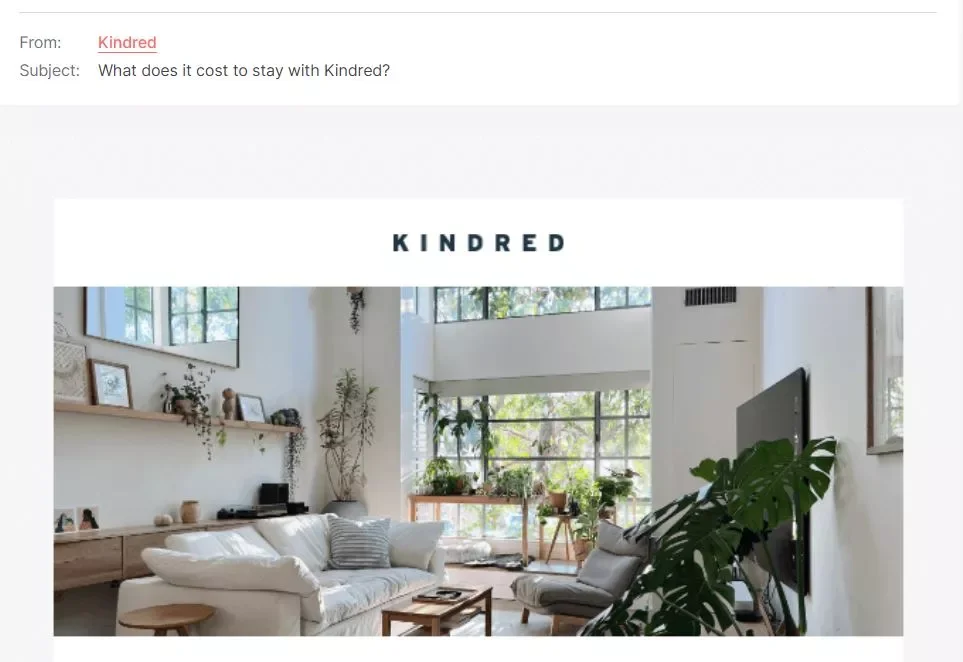
Clear and persuasive body text
Once your subject line has done its job, the body of your email must keep the reader engaged.
Here are strategies to write clear and persuasive email copy:
- Start with a strong opening: Your header should hook your reader. You can begin with a compelling statistic, an intriguing fact, or a relatable anecdote.
- Follow a readable layout: Use short paragraphs and bullet points to break up text. This can make your email easier to read.
- Focus on benefits, not just features: Highlight value in your email. Explain how your product or service solves a problem or meets a need.
- Maintain a conversational tone: Write as if you’re speaking directly to the reader. This can make your email feel more personal. Avoid overly formal language unless it’s necessary for your audience.
Visuals and multimedia
Visual elements can enhance your email content and make it more engaging. Use high-quality images that are relevant to your message.
You can also use infographics to convey complex information. They’re effective for summarizing data or processes.
You can also embed a short video to increase engagement. Ensure that all visuals are responsive and look good on mobile devices. Since many people check emails on their phones, this is crucial for maintaining engagement.
Personalization techniques
The act of personalizing emails goes beyond just using the recipient’s name. Some of the ways you can tailor your emails include:
- Segmenting your audience and sending targeted messages that resonate with specific groups
- Using behavioral data to send personalized recommendations
- Creating special offers based on the recipient’s previous purchases or browsing behavior
- Using dynamic content blocks that change based on the recipient’s data
Strong CTAs
Your emails should always include a clear call to action. Use action-oriented language that tells the reader exactly what to do. For instance, instead of using a generic term like “Click here,” you can use specific and action-oriented phrases. Examples include “Download your free guide now” or “Shop the sale today.”
Strategic placement of your CTA is also important. You can include it at the beginning and the end of your email to capture readers at different points in their reading journey.
Email marketing metrics and analytics
Email analytics are important for harnessing the full potential of your marketing strategy. You must track performance and continuously optimize your campaign to achieve better results.
Let’s explore the key metrics you can track and how to interpret the data for your campaigns.
Key metrics
Email metrics can show various aspects of campaign performance.
Here’s a list of some of the most impactful email performance metrics you can track:
- Open rate: The percentage of recipients who opened the email
- Conversion rate: The percentage of recipients who completed a desired action
- Click-through rate (CTR): The percentage of recipients who clicked a link in the email
- Bounce rate: The percentage of emails that couldn’t be delivered
Analytics tools
There are several tools and platforms to track and analyze your email marketing performance. Some of the most popular options include:
- Email service providers (ESPs): Most ESPs, such as Omnisend, Mailchimp, and more, offer built-in analytics dashboards.
- Google Analytics: You can integrate your email campaigns with Google Analytics to track user behavior. With this, you can discover how email traffic contributes to your overall website performance.
Setting benchmarks and interpreting email marketing campaign data
Once you’ve collected performance data, you must analyze and interpret it. This helps identify areas where you can improve your campaigns and make adjustments.
Here are some tips for interpreting email marketing data:
- Compare your metrics to industry benchmarks: Look up average rates for different email metrics for your industry to establish a baseline for comparing your performance.
- Identify trends over time: Check for patterns in your data. Examples are increases or decreases in open rates or click-through rates.
- Compare data with your marketing goals: In addition to comparing to industry standards, check if you’re meeting your marketing objectives as well. This helps you determine which areas need improvement.
Common email marketing mistakes to avoid
Nearly every marketer makes mistakes at some point. It’s a normal part of the learning process.
Instead of letting this limit your email campaigns, you can focus on managing mistakes when they occur. Familiarize yourself with common email marketing mistakes to avoid them altogether.
Here are some errors to avoid:
Mistake 1: Overloading subscribers with too many emails
- Spam risk: Sending too many emails increases the risk of being marked as spam. Email providers track spam reports, and high rates can damage your sender reputation.
Mistake 2: Ignoring email design and user experience
- Readability issues: Emails with small fonts, poor color contrast, or cluttered layout can be hard to read. This can lead to lower engagement and higher bounce rates.
- Mobile unfriendliness: Many people read emails on their phones. If your email designs aren’t mobile-friendly, you risk losing a large portion of your audience.
Mistake 3: Sending emails without testing
- Errors slip through: Without testing, mistakes like broken links, typos, and incorrect formatting can slip through. Also, emails display differently across email clients and devices. By skipping the testing phase, you miss out on the chance to spot any discrepancies and address them.
Mistake 4: Not segmenting your email list
- Poor personalization: Without segmentation, personalizing your emails is difficult. Audiences have unique needs and interests. Not segmenting your list means missing the chance to send targeted messages.
Mistake 5: Failing to track and analyze performance
- Missed insights: If you’re not tracking your performance, you’d be running your email marketing campaigns blindly. You won’t know what’s working and what’s not. This could lead to repeated mistakes and missed opportunities for improvement.
Conclusion
Email marketing offers the possibility of an impressive ROI that exceeds most marketing methods. When executed correctly, it can deliver significant results.
We’ve covered a lot of ground in this guide — from email marketing definition and importance to strategies for enhancing engagement and conversions.
Now, it’s time to put these insights into action. Implement the strategies that resonate with your audience and business goals. Remember, any email marketing strategy requires continuous testing and refinement.
If you need additional support or resources, sign up for a one-on-one demo to learn how to use our robust email marketing features.
Source from Omnisend
Disclaimer: The information set forth above is provided by omnisend.com independently of Alibaba.com. Alibaba.com makes no representation and warranties as to the quality and reliability of the seller and products. Alibaba.com expressly disclaims any liability for breaches pertaining to the copyright of content.
